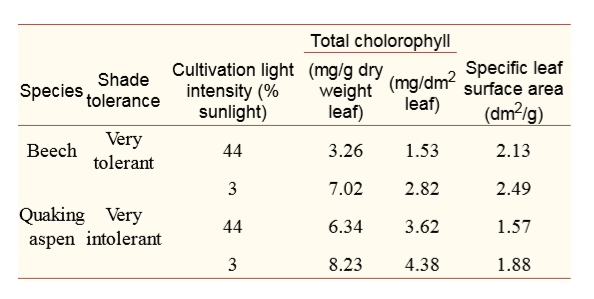
Concept explainers
To review:
The mechanism by which plant adjust their chlorophyll levels under different light conditions. Also explain the reason for this chlorophyll adjustment.
Given:
Table 1 represents the data related to chlorophyll adjustment in the plants grown in different light conditions.
Table 1: The data showing adjustment of chlorophyll in the plants, cultivated in different light intensity.

Here, mg/g is milligram per gram, mg/dm2 is milligram per decimeter square, and dm2/g is decimeter square per gram.
Introduction:
The process of photo synthesis is driven by the sunlight, which shows a number of variations in light intensities. Generally, to cope with the fluctuations in light intensities, they follow various adaptations to control the absorption of varying light intensities. Photosystems play a vital role in regulating the amount of light energy that is transferred to the reaction center.
Want to see the full answer?
Check out a sample textbook solution
Chapter 10 Solutions
Life: The Science of Biology
- explain which colors of light a plant with just chlorophyll a would result in the highest photsynthetic output. Why would a yellow only light scenario not be ideal for plant containing both chlorophyll a and chlorophyll b.arrow_forwardIn hot, dry climates, plants have evolved mechanisms to avoid photorespiration. Which of the following is FALSE Select an answer and submit. For keyboard navigation, use the up/down arrow keys to select an answer. a b с d e C3 plants have no mechanism to avoid photorespiration C4 plants reduce photorespiration by separating the light reaction in the mesophyll cells from the light- independent reaction in the bundle-sheath cells CAM plants minimize photorespiration by collecting and storing CO2 at night and keeping their stomata closed during the day C4 plants include corn, sugarcane, and many grasses CAM plants can undergo photophosphorylation in the absence of sunlight Open in Readirarrow_forwardLight that the chlorophyll-a pigment uses may be measured by the solar-induced fluorescence (650-850nm). This fluorescence caused by the sun and a plant's gross primary output are correlated linearly. Why can solar induced fluorescence be used to infer net photosynthesis?arrow_forward
- Discuss in detail photorespiration in plants.arrow_forwardIn a paragraph, summarize the details of the light-independent reaction. Exxplain the role of ATP and NADPH and where this reaction takes place.arrow_forwardDefine photorespiration. Explain at least one method some plants use to avoid photorespiration.arrow_forward
- discussmorphological differences between sunny and shady setups of mung beans in relation to phototropic response of plantsarrow_forwardThe green color of plants is explained by the wavelengths of light that are reflected, transmitted, and absorbed by the chlorophylls in the thylakoids. Which of the following statements is true? Plants appear green because chlorophylls reflect and transmit yellow and green wavelengths of light, and absorb red and violet-blue wavelengths of light. Plants appear green because chlorophylls reflect and transmit red and blue wavelengths of light, and absorb yellow and green wavelengths of light. Plants appear green because chlorophylls reflect and transmit red and blue wavelengths of light, and absorb white wavelength of light. Plants appear green because chlorophylls reflect and transmit white wavelength of light, and absorb red and violet-blue wavelengths of light.arrow_forwardDescribe the relationship between transpiration rate and light intensity in basil Ocimum basilicum in terms of photosynthesis, optimal range, and stomata.arrow_forward
- Discuss whether it would be more beneficial to improve the light or dark reactions in order to enhance photosynthesis for a future scenario of extreme drought conditions. Please draw sketches to illustrate and include atleast 20 pointsarrow_forwardUse the data to create a graph in Excel. It should be a scatter plot with a line connecting each point. Looking at the graph: a/ Which wavelengths absorbed most by spinach and likely used for photosynthesis? b/ Which wavelengths are absorbed least?arrow_forwardWhat are the outputs from the light Reactionsarrow_forward
 Human Anatomy & Physiology (11th Edition)BiologyISBN:9780134580999Author:Elaine N. Marieb, Katja N. HoehnPublisher:PEARSON
Human Anatomy & Physiology (11th Edition)BiologyISBN:9780134580999Author:Elaine N. Marieb, Katja N. HoehnPublisher:PEARSON Biology 2eBiologyISBN:9781947172517Author:Matthew Douglas, Jung Choi, Mary Ann ClarkPublisher:OpenStax
Biology 2eBiologyISBN:9781947172517Author:Matthew Douglas, Jung Choi, Mary Ann ClarkPublisher:OpenStax Anatomy & PhysiologyBiologyISBN:9781259398629Author:McKinley, Michael P., O'loughlin, Valerie Dean, Bidle, Theresa StouterPublisher:Mcgraw Hill Education,
Anatomy & PhysiologyBiologyISBN:9781259398629Author:McKinley, Michael P., O'loughlin, Valerie Dean, Bidle, Theresa StouterPublisher:Mcgraw Hill Education, Molecular Biology of the Cell (Sixth Edition)BiologyISBN:9780815344322Author:Bruce Alberts, Alexander D. Johnson, Julian Lewis, David Morgan, Martin Raff, Keith Roberts, Peter WalterPublisher:W. W. Norton & Company
Molecular Biology of the Cell (Sixth Edition)BiologyISBN:9780815344322Author:Bruce Alberts, Alexander D. Johnson, Julian Lewis, David Morgan, Martin Raff, Keith Roberts, Peter WalterPublisher:W. W. Norton & Company Laboratory Manual For Human Anatomy & PhysiologyBiologyISBN:9781260159363Author:Martin, Terry R., Prentice-craver, CynthiaPublisher:McGraw-Hill Publishing Co.
Laboratory Manual For Human Anatomy & PhysiologyBiologyISBN:9781260159363Author:Martin, Terry R., Prentice-craver, CynthiaPublisher:McGraw-Hill Publishing Co. Inquiry Into Life (16th Edition)BiologyISBN:9781260231700Author:Sylvia S. Mader, Michael WindelspechtPublisher:McGraw Hill Education
Inquiry Into Life (16th Edition)BiologyISBN:9781260231700Author:Sylvia S. Mader, Michael WindelspechtPublisher:McGraw Hill Education





